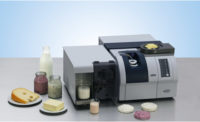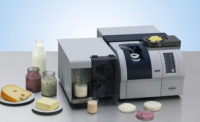Speed, accuracy and consistency are three metrics that managers of dairy processing plants should be measuring. An on-site dairy laboratory can play an important role in achieving high values in each of those metrics. Fast and accurate results contribute to food safety and manufacturing efficiency. Testing of raw ingredients and finished product helps a dairy processor achieve consistency in taste, texture and color.
Many dairy processors do their own testing in on-site labs and others use third-party laboratories. Some do both. The trend is to bring more testing in-house, said Megan Roush, a market development manager for Neogen Corp., Lansing, Mich., one of several testing suppliers interviewed for this article by Dairy Foods.
Two advantages of on-site labs are cost savings and shortened time to receive results, she said. A fast lab can even reduce real estate requirements because by receiving test results quickly, a processor needs less warehouse space to hold product, she noted.
Dean E. Roberts of Bruker Optics, Madison, Wis., said “the most significant advantage” to an on-site lab “is the ability to use near real-time results to control individual unit operations within the plant. This leads to better product consistency and the ability to operate closer to USDA specifications, where applicable.”
Government rules, however, are leading some processors to consider third-party labs. The implementation of the Food Safety Modernization Act creates “some fairly tall demands on manufacturers,” said Wes Shadow, business development manager for Perten Instruments, Springfield, Ill. “Our customers indicate they are increasing screening of incoming materials to keep poor performing, off-quality or even adulterated materials out of the process in the first place. Rapid tests and data/results integration are key.”
He said that, generally, what has to be tested for either safety or manufacturing needs is done in-house. Those tests that can ‘wait’ are being sent to outside labs.
“The advantages of increasing in-house testing are pretty profound as they can have positive impacts on productivity, profitability and food safety. The primary hardship at this point is that it requires companies to re-think the way they have tested traditionally. That requires training,” Shadow said.
It can be expensive to set up an on-site lab. Besides buying and maintaining the equipment, a dairy needs to hire and train staff. While a lab technician is critical to food safety, the position does not call for a college degree; a high school diploma is usually sufficient, suppliers say. That’s because testing equipment is easy to use.
Equipment and payroll costs need to be weighed against the time it takes to receive results from a third-party lab. A dairy plant cannot make adjustments to processing equipment and cannot optimize production procedures until it has the results, said Process Product Manager Devin Darrell of CEM Corp., Matthews, N.C.
Other dairy processors are expanding their in-house lab capabilities but not necessarily at the central lab, said Jackie Page, president of Page & Pederson International, Hopkinton, Mass. She said “satellite labs have morphed into at-line and on-line.” These labs are engaged in real-time testing for particular parameters.
In-line NIR (near infra-red) transmission analyzers measuring fat, moisture and protein can deliver results in one minute or less continuously, said Todd Nelson of ProSpect Analytical Technology, Plymouth, Minn.
With an in-line analyzer measuring fat percentages, protein and moisture content as product goes through the pipeline, blending and formulation can be automatically controlled, said Rick Cash, marketing technology manager, Thermo Fisher Scientific, Minneapolis.
“This frees up plant personnel and speeds up production. Ultimately the quality of the final product is improved and more consistent,” he said.
Work-in-progress testing can help processors make changes to reduce waste or out-of spec-product that would need formulation, said Ryan Taylor, Perten’s Midwest regional manager. Finished product testing can help with release of product more rapidly, thus saving warehouse/storage space and allowing for more output to customers in a timely manner, he added.
Testing for allergens, pathogens
Dairies also test for allergens and pathogens. Neogen’s Roush noted that dairies should develop an allergen control plan that identifies all of the allergenic proteins coming into the plant.
“These allergens should be routinely tested for in the environment as well as in product that does not contain the allergenic protein,” she said.
Dairies also need to avoid cross-contamination with manufacturing. One way to do that is to run all like allergens on the same line when possible, Roush said. And after cleaning all equipment, technicians should test surfaces to verify that there are no allergenic proteins present before starting the next run of product, she said.
Cleaning crews need to look for allergenic proteins in difficult-to-clean areas of the manufacturing line, especially in areas that have caused problems in the past, she said. “Maintain separate cleaning and storage equipment for each allergenic protein present in the plant.”
Known trouble spots, such as filler heads or screw drives, should be tested between production runs and after sanitation to ensure a nonallergenic food product is not contaminated with a known food allergen, Roush said.
Allergen testing is important because allergens top the list of warning letters and recalls, said Nancy H. Eggink, technical service director of 3M Food Safety, St. Paul, Minn.
“Extra focus should be given on how the dairy will manage packaging to ensure it matches up with the product formulation,” she said.
Validation testing should determine if cleaning and sanitation procedures are effective at removing the allergenic protein from the surface. The verification test should be quick and easy to show the standard operating procedure was carried out effectively each day, she said.
As for pathogens, the three most common are Listeria monocytogenes, Salmonella and E. coli. Depending on the product being made, one of these may demand more testing than the others, Roush said. For example, Salmonella is commonly tested for in dry milk powders because it prefers to grow in dry environments, while Listeria monocytogenes prefers to grow in environments with higher moisture. Depending on the level of risk, testing should be done on both environmental samples and finished product samples, she said.
Eggink said that dairies should consistently include Listeria as a biological hazard as part of their risk assessment process. A plant manager should first identify the areas of highest risk in a plant and then employ a zone assessment and management approach. The focus should be to find and eradicate Listeria in Zones 3 and 4 to prevent it getting into Zones 1 and 2. Floor drains are a common swabbing location, but Listeria thrives in cool, damp environments. A thorough risk assessment of the entire plant is recommended, she said.
Avoid waste
Milk, the raw material for all dairy products, is not inexpensive. Having accurate analyses of raw materials and in-process and finished products enables dairy manufacturers to make the most of their raw materials and finely optimize their processes for the maximum yield and profit, noted CEM’s Darrell.
Many dairy products have functional and compositional requirements, said Perten Instrument’s Shadow. While a material could meet the requirements for moisture or protein, it might not gel or melt at the correct temperature. That is a reason why labs should not just screen for composition, he said. Testing raw and in-process materials is critical to make certain that end products will have the desired traits — texture, mouthfeel, protein content, shelf life and more.
Darrell noted that milk and cream are bought based on butterfat content. Testing the fat content of a shipment helps a dairy to know that it is not overpaying for raw materials, he said. Rapid in-process testing gives production managers the information they need to make batch adjustments quickly, eliminate out-of-specification product and minimize production costs. Final product testing is necessary to ensure that the product meets quality control and regulatory requirements.
Bruker Optics’s Roberts makes a similar point. “Continuous testing from incoming raw materials to final product helps ensure that the most expensive, important ingredients wind up in the product and not in a waste stream,” he said.
Traditional fat tests are the Mojonnier and Babcock methods, which Darrell called “time-consuming techniques which involve hazardous chemicals and require a trained chemist to perform.”
Faster methods include NIR (near infrared) systems, hybrid systems combining rapid microwave drying with NMR technology, and spectroscopic methods like FT-NIR. These faster systems allow for much higher testing rates to be maintained without any significant increase in laboratory costs, Roberts said.
Whatever testing system a dairy chooses, the equipment needs to be maintained. CEM’s Darrell said good laboratory practices include proper calibration procedures for balances and other measuring equipment, as well as periodic checks of rapid methods against long method techniques.
Safety first, but speed, accuracy are a close second
NSame-day results from microbial testing have many benefits for raw material testing, plant environmental monitoring and finished product testing. Fred Weber, president of Weber Scientific, Hamilton, N.J., shares these reasons for thorough testing of allergens, pathogens and products.
Raw materials
- Prevent contaminated materials from entering production
- Avoid hold times that shorten shelf life
- Prevent equipment down time
- Quickly verify Certificates of Analysis
Plant environment
- Rapidly evaluate the effectiveness of cleaning and sanitation from a microbial perspective
- Document due diligence
- Identify and troubleshoot in hours instead of days
Finished Product
- Release product sooner
- React to contamination before shipment
- Prevent recalls
- Reduce outside laboratory costs
- Protect your brand and reputation
Free Test Evaluates Powder Behavior, Flowability
Brookfield Engineering Laboratories offers free powder sample testing using the company’s powder flow tester to characterize a powder’s behavior and flowability. The testing determines flow function, wall friction, arching diameter and bulk density as a function of consolidation stresses. Tests are typically completed in less than a week and the results are e-mailed to the customer. To schedule free sample testing, contact Vinnie Hebert, 800-628-8139 or e-mail v_hebert@brookfieldengineering.com.







